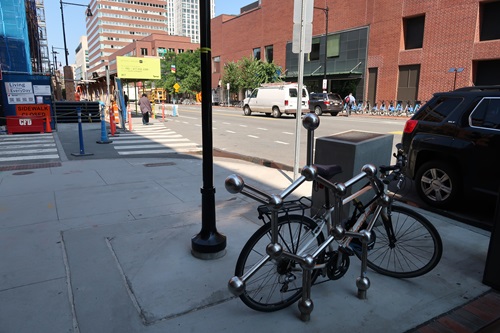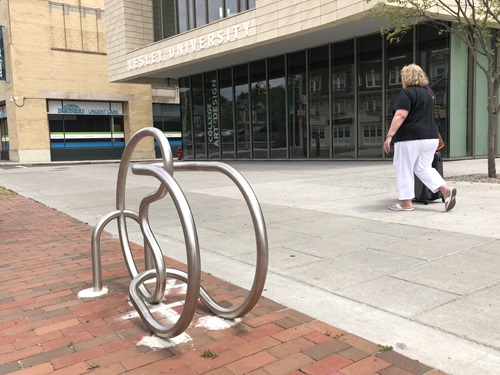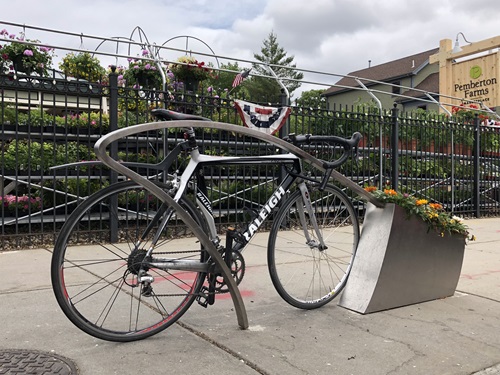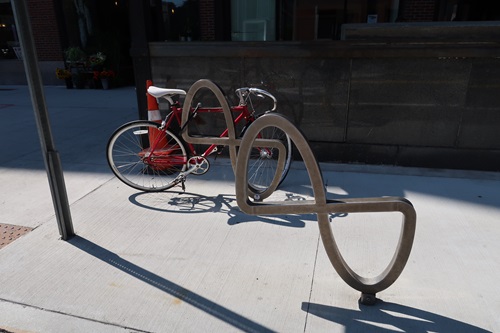Artist Designed Bike Racks
In 2012, Cambridge Arts hosted the City’s first bike rack design competition for Main Street in Kendall Square. Five artists were selected from the CAC Artist Registry by an independent jury and subsequently invited to submit proposals for unique bike rack designs that bring playfulness and functionality to a ubiquitous and important sidewalk object. The artists selected to create designs were Vivian Beer, Carrie Bodle, Matthew Hincman, Case Randall, and Aaron Stephan.
As the City of Cambridge continues to promote bicycling as a healthy and sustainable form of transportation, the need for bike racks is ever increasing. During this time, the 1000+ bike racks currently installed on public property throughout the City were expanded to include an addition of eight seasonal “cycle stalls,” new playful racks for public school sites, and the selected artist-designed bike racks.
Each artist had to balance her or his artistic mission with factors of successful functionality, ease of maintenance, compliance with the Americans with Disabilities Act, and economy of cost. Each artist has created three or four designs that were represented in the Cambridge Arts’ Gallery 344 by drawings, models, and artists’ statements. During the exhibit and at the April 10, 2012 Kendall Square Public meeting, members of the public were asked to comment and vote on the different designs. Approximately 650 votes were received.
Final chosen designs were fabricated by Dero Bike Rack Company of Minnesota and originally installed on Main Street. The originally location was selected because the City of Cambridge was engaged in a design process for the reconstruction of Main Street between Wadsworth and Ames Streets. This construction project primarily addressed surface infrastructure needs such as landscaping, lighting, traffic flow, and support of local businesses, with the additional purpose of creating a framework for future improvements in the larger Kendall Square area.
On June 4, 2012 the selection committee met and selected 5 bike racks to be used in Kendall Square. The selection committee included city staff, a member of the Bicycle Committee and two members of the Kendall Square Advisory Committee. In making their selection, the committee considered the public input (voting and comments), functionality of the racks, appropriateness for Kendall Square, and artistic interest.
Since the initial installation, some of the artist designed bike racks have been moved to new locations throughout the City.
Selected Artists and Designs:

Caffeine Molecule, Case Randall, Located on Main St.
Case Randall Artist Statement:
The caffeine molecule was inspired by the future location of the racks, Technology Square. I thought it would be a fun inside joke for the scientists who would recognize the molecular structure on their morning commute. Two other of my [liquid style] bike rack designs were inspired by bronze sculptures I have made. I wanted to design a bike rack that was playful, sculptural, and colorful.
Case Randall is a Cambridge resident and maintains a studio in Dudley Square, Boston. She earned a B.F.A. from Massachusetts College of Art in 2006. Working primarily in bronze, Randall explores various dichotomies pertaining to the human body. Her themes are those of mutation and mutilation, creation and destruction, humor and horror. Her sculptures attempt to depict the ambiguous intersection where one may be visually indistinguishable from another through but extreme abstractions that become figures of their own.

Link, Matthew Hincman, Located on Massachusetts Avenue
Matthew Hincman Artist Statement:
Each rack is a complete system comprised of two or more autonomous figures - none of which touch each other - but rather intertwine and/or hover near each other. A bicycle secured to the system is a part of that system. The locked bike becomes engaged in the conversation and tensions between the parts of the system.
An object (man-made or otherwise) appropriated as a tool for unintended or novel purposes is a fascinating example of human ingenuity. The manner in which bikers lock their bicycles up to things - trees, trash cans, parking meters, buildings, etc. - illustrates that individual's answer to an ordinary problem: how can I secure my bike, here in this place, so no one takes it? These racks afford cyclists the opportunity to safe-keep their bikes, and also to creatively engage with their environment.
Matthew Hincman is originally from Lynn, Massachusetts, and lives in the Boston area. Hincman graduated from the Massachusetts College of Art and received an MFA from University of California, San Diego. He helped found MAKE Architectural Metalworking. He has shown at numerous galleries around Boston, and in 2007 received a Massachusetts Cultural Council Individual Artist Award. He is currently an Assistant Professor at the Massachusetts College of Art and Design.

Planter A, Vivian Beer, Located on Massachusetts Avenue
Vivian Beer Artist Statement:
What is more beautiful than flowers on a city street?
In this design I combined the function of a bike rack with a large planter. There are two versions. One places the top of the planter low to the ground and would be ideal for brightly colored, perhaps annual flowers. The second is higher, with the idea that ivy, or a creeping ground planting could be cultivated to dangle over the side. Aesthetically the profile is a combination of streamline design and the shapes of glacially formed islands along the New England coastline. It would be fabricated from plate steel and square tubing with a galvanized finish.
Vivian Beer grew up in rural Maine, where the development of hand skills and the making of objects was a part of everyday life. This understanding of design as a hands-on process has influenced the format of both process and product throughout her career. Vivian tiptoes through contemporary design, craft and sculptural aesthetics, sampling from each one. She counterbalances a strong knowledge of contemporary furniture design with the history of industry and architecture to create furniture that intends to transform our expectations of and relationships to the domestic landscape. She holds a BFA from the Maine College of Art (2000) and an MFA from Cranbrook Academy of Art (2004) and was a resident at the Penland School in NC (2005-2008). She lives and works in New England, teaches and exhibits nationally.

Sine Wave, Carrie Bodle, Located on Main St
Carrie Bodle Artist Statement:
Inspired by the history of science, technology, and innovation in Kendall Square, I propose sine wave bike racks for the Kendall Square Redevelopment Project. Sine waves occur in mathematics, physics, and sound. They form the basis for the transmission of signals and can be found in the pattern of a rotating bike wheel. My work as a visual and sound artist explores the relationships between art and science which was sparked by my time at MIT as a graduate student in the Visual Arts Program. It is my intention with this bike rack design proposal to create a memorable experience reflecting the energy of an academic and entrepreneurial incubator area such as Kendall Square.
Carrie Bodle’s work as a visual and sound artist explores the inherent experience of time, site, and material. The coupling of place, media, and sensory experience has engaged her to investigate intangible relationships that evoke questions of presence, distance, temporality, and permanence. Artist residencies and fellowships include Rockefeller Foundation Bellagio Center, IBM Watson Collaborative User Experience Group in Cambridge, MA and 911 Media Arts Center/Henry Art Gallery in Seattle, WA. Bodle received her Master's of Science in Visual Studies from the MIT Visual Arts Program and since 2006 has been a visiting lecturer at the University of Washington in the School of Art. Her work has been shown at the Location One Gallery in NYC, the DeCordova Museum in Lincoln, MA, and webcast by radioartemobile through the Center for Advanced Visual Studies, CAVS, at MIT.